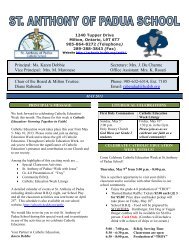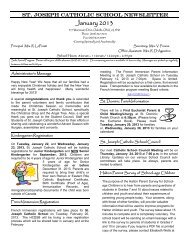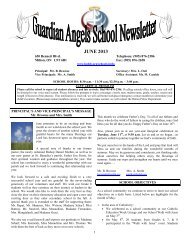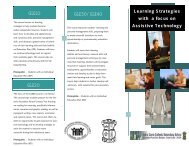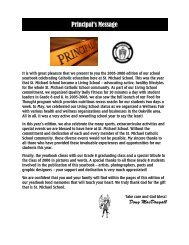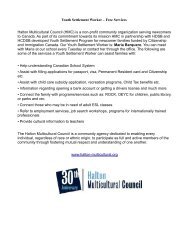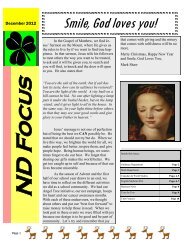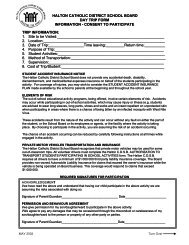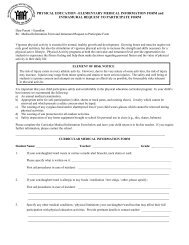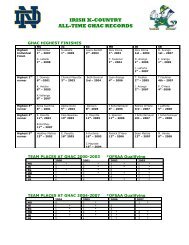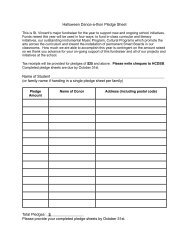Daily Physical Activity in Schools
Daily Physical Activity in Schools
Daily Physical Activity in Schools
Create successful ePaper yourself
Turn your PDF publications into a flip-book with our unique Google optimized e-Paper software.
Introduction<br />
General Teach<strong>in</strong>g Strategies 1<br />
Teachers should ensure that students have all the <strong>in</strong>formation they need to participate<br />
<strong>in</strong> the activities, and that the appropriate procedures are followed while students are<br />
engaged <strong>in</strong> daily physical activities.<br />
In all physical activity, it is essential that safety be a prime consideration. The follow<strong>in</strong>g<br />
are some general guidel<strong>in</strong>es to assist teachers as they implement daily physical activity.<br />
Introduce general rules and procedures at the beg<strong>in</strong>n<strong>in</strong>g of the year (e.g., rules<br />
about fair play, respect for others, safety).<br />
Ensure that students understand clearly the rules and procedures that apply <strong>in</strong><br />
different physical activity areas, <strong>in</strong>clud<strong>in</strong>g the classroom.<br />
Ensure that students are dressed appropriately for daily physical activities.<br />
Outl<strong>in</strong>e the curriculum expectations that relate to daily physical activity to help<br />
students take responsibility for achiev<strong>in</strong>g those expectations.<br />
Ensure that all <strong>in</strong>structions are clear and that students pay close attention to<br />
<strong>in</strong>structions. When <strong>in</strong>structions are be<strong>in</strong>g provided, ensure that all students are<br />
able to see the leader and that the leader can see all the students. If the class is<br />
held outside, ensure that students’ view is not obstructed by the sun.<br />
Establish clear start and stop signals. Whistles can be effective if not overused.<br />
Start signals are just as important as the stop signal (e.g.,“When I say ‘go’,<br />
you can beg<strong>in</strong> the activity. Go!”). Use audio and/or visual signals (e.g., stopp<strong>in</strong>g<br />
the music, putt<strong>in</strong>g a hand up), where appropriate. When students can<br />
respond to brief signals, not only is their attention engaged, but their activity<br />
time also <strong>in</strong>creases.<br />
Use of music<br />
Music can be an excellent<br />
motivator for students when<br />
they participate <strong>in</strong> physical<br />
activities. Play upbeat music<br />
with a fast tempo dur<strong>in</strong>g the<br />
warm-up to motivate children<br />
to move quickly and energetically.<br />
Dur<strong>in</strong>g the cool-down,<br />
play slower and quieter music<br />
to help create a calm and<br />
relaxed mood. Allow<strong>in</strong>g children<br />
to select music (with<strong>in</strong> certa<strong>in</strong><br />
guidel<strong>in</strong>es) can have a significant<br />
positive impact on the<br />
atmosphere <strong>in</strong> the class.<br />
Use clear visual cues, such as l<strong>in</strong>es on the floor and pylons, to help identify<br />
boundaries dur<strong>in</strong>g activities.<br />
Ensure that spac<strong>in</strong>g between groups is adequate so that one group’s activity<br />
does not <strong>in</strong>terfere with another group’s activity.<br />
Strategies to Motivate Students<br />
There are many ways to motivate students to be more physically active. Here are some<br />
suggestions.<br />
Make physical activity fun.<br />
Be enthusiastic and provide encouragement.<br />
Ensure that students feel comfortable ask<strong>in</strong>g questions and discuss<strong>in</strong>g concerns.<br />
Keep <strong>in</strong>structions short and simple to maximize activity time and keep students<br />
engaged.<br />
Encourage students to talk to peers while be<strong>in</strong>g physically active.<br />
Set realistic expectations for each student, and modify skills and activities where<br />
necessary.<br />
Praise students when they are do<strong>in</strong>g th<strong>in</strong>gs correctly, and provide ongo<strong>in</strong>g<br />
constructive feedback.<br />
Involve students <strong>in</strong> plann<strong>in</strong>g physical activities, and allow for some choice.<br />
1. Many of the strategies and suggestions <strong>in</strong> this and the follow<strong>in</strong>g sections are adapted from: Ophea, H&PE Curriculum<br />
Support Documents, Grades 1 to 8, 2000.<br />
5



